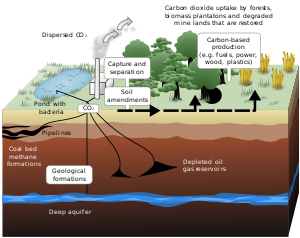
Carbon sequestration means removing carbon (as carbon dioxide) from the atmosphere and locking it up in a form where it will not enter the atmosphere for many years.
It is sometimes used to refer specifically to carbon capture and storage of from industry (especially power plants), where CO2 is separated from flue gas to be buried underground. Critics argue that this is an unproven geoengineering technique which will take decades to develop to a commercial scale. If successful, it could help slow climate change but it is currently being used an excuse for the business as usual case, in terms of continuing with exploration, extraction & combustion of fossil fuels. When compared to off the shelf renewable energy options, Carbon Sequestration is not economically viable.
Oceanic algae[edit | edit source]
Algal blooms store carbon when they die and fall to the ocean floor. These can be promoted by sprinkling nutrients, such as iron or urea, but little is known about the effects on the ecosystem, and how to prevent the growth of toxic algae.[1]
Notes[edit | edit source]
- ↑ UC Santa Cruz scientists find toxic algae in open ocean, November 13, 2010